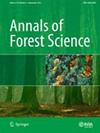挪威云杉木材的潜在替代品:基于无缺陷木材特性的选择
IF 2.7
3区 农林科学
Q1 FORESTRY
引用次数: 0
摘要
应用材料选择原理发现了8种可能替代挪威云杉(Picea abies (L.))的树种(2种落叶树种和6种针叶树种)。喀斯特),并可能防止欧洲森林的经济损失。气候变化是中欧森林和木材工业面临的主要挑战。日益增加的生物(如甲虫损害)和非生物(如干旱)灾害导致森林价值的重大损失,特别是挪威云杉(Picea abies (L.))。喀斯特林。因此,有必要向适应气候变化的森林管理过渡。同时,新生植物(如天树)(Ailanthus altissima (Mill.))杉木(pseudosuga menziesii (Mirbel) Franco)、冷杉(Abies grandis (Douglas ex D. Don) Lindl.)和泡桐(Paulownia tomentosa (Thunb.))。))正在增加它们在森林群落中的主导地位,并引起森林生态系统的额外适应。这两个因素将导致中欧森林的木材种类分布在未来几十年发生重大变化,主要是在挪威云杉的广阔地区。为植树造林选择“正确”的树种将变得越来越复杂,需要将林业和技术方面结合起来的整体方法。因此,本综述提出了一种基于文献中可用木材材料数据和M. Ashby提出的材料选择原则的选择方法,旨在为挪威云杉(Picea abies (L.))确定合适的替代品。H. Karst.),并进一步简明地评估它们的造林相关性。方法以干密度、生料密度、抗弯强度、弹性模量为主要性能指标,进行树种对比和选择。梁类和板类构件受弯曲载荷的选择作为代表性的使用案例。结果欧洲桦树(Betula spp.)、大冷杉(Abies grandis (Douglas ex D. Don) Lindl.)和银杉(Abies alba Mill.)被确定为挪威云杉(Picea Abies (L.))的适宜替代品。H.喀斯特)从技术和造林的角度来看。此外,泡桐(Paulownia tomentosa, Thunb.)),锡特卡云杉(Picea sitchensis) (Bong.)carririre)、黄松(Pinus strobus L.)、西部红杉(Thuja plicata Donn ex D. Don in Lambert)和火炬松(Pinus taeda L.)具有技术优势,但目前在林业部门缺乏相关性。建议的选择过程提供了对技术性能的评估,并结合对造林相关性的评估,将有可能优化木材供应链并防止中欧森林未来的经济损失。本文章由计算机程序翻译,如有差异,请以英文原文为准。

Potential alternatives for Norway spruce wood: a selection based on defect-free wood properties
Abstract Key message The application of material selection principles uncovered eight possible alternative tree species (two deciduous and six coniferous species) to substitute Norway spruce ( Picea abies (L.) H. Karst.) and potentially prevent economic loss in European forest. Context Climate change is a major challenge for the Central European forest and timber industry. Increasing biotic (e.g. beetle damage) and abiotic (e.g. drought) calamities have led to major losses in forest value, especially on Norway spruce ( Picea abies (L.) H. Karst.) stands. Therefore, a transition to climate change adapted forest management is necessary. Concurrently, neophytes (e.g. tree of heaven ( Ailanthus altissima (Mill.) Swingle), Douglas fir ( Pseudotsuga menziesii (Mirbel) Franco), grand fir ( Abies grandis (Douglas ex D. Don) Lindl.) and Paulownia ( Paulownia tomentosa (Thunb.) Steud.)) are increasing their dominance in forest communities and causing additional adaption of the forest ecosystem. Both factors will lead to significant changes in wood species distributions in Central European forests, mainly at the expanse of Norway spruce, over the next decades. Aims Choosing the “right” tree species for afforestation will become ever more complex and will require a holistic approach that combines forestry and technological aspects alike. Therefore, this review presents a selection approach based on available wood material data from literature and the material selection principles proposed by M. Ashby with the aim to identify suitable alternatives for Norway spruce ( Picea abies (L.) H. Karst.) and further concisely assess their silvicultural relevance. Methods For this wood species comparison and selection process, dry and raw density, bending strength and modulus of elasticity were chosen as key properties. Beam- and plate-like components subjected to a bending load were chosen as representative use cases. Results European birch ( Betula spp.), grand fir ( Abies grandis (Douglas ex D. Don) Lindl.) and silver fir ( Abies alba Mill.) were identified as suitable alternatives for Norway spruce ( Picea abies (L.) H. Karst.) from a technological as well as silvicultural point of view. In addition, Paulownia ( Paulownia tomentosa (Thunb.) Steud.), Sitka spruce ( Picea sitchensis (Bong.) Carrière), yellow pine ( Pinus strobus L.), western red cedar ( Thuja plicata Donn ex D. Don in Lambert) and loblolly pine ( Pinus taeda L.) offer a technological advantage but currently lack relevance in the forest sector. Conclusion The proposed selection process offers an evaluation of technical performance, and in combination with an assessment of the silvicultural relevance, it will be possible to optimize the wood-supply chain and prevent future economic loss of Central European forests.
求助全文
通过发布文献求助,成功后即可免费获取论文全文。
去求助
来源期刊

Annals of Forest Science
农林科学-林学
CiteScore
6.70
自引率
3.30%
发文量
45
审稿时长
12-24 weeks
期刊介绍:
Annals of Forest Science is an official publication of the French National Institute for Agriculture, Food and Environment (INRAE)
-Up-to-date coverage of current developments and trends in forest research and forestry
Topics include ecology and ecophysiology, genetics and improvement, tree physiology, wood quality, and silviculture
-Formerly known as Annales des Sciences Forestières
-Biology of trees and associated organisms (symbionts, pathogens, pests)
-Forest dynamics and ecosystem processes under environmental or management drivers (ecology, genetics)
-Risks and disturbances affecting forest ecosystems (biology, ecology, economics)
-Forestry wood chain (tree breeding, forest management and productivity, ecosystem services, silviculture and plantation management)
-Wood sciences (relationships between wood structure and tree functions, and between forest management or environment and wood properties)
 求助内容:
求助内容: 应助结果提醒方式:
应助结果提醒方式:


